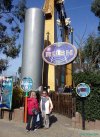So 600A roughly for the ride. The things like lighting and signage and tv monitors are miniumal with LED drivers.
BLUF
I'm not sure how you came up with a figure of 600A I get 1443.38 total. (2 significant digits)
It is also worth noting that Amps is just a measurement of
resistance (EDIT) CURRENT. What we care about are the Watts,
(EDIT) a measurement of energy transfer.
(about the edit: I had Ohms Law on the brain and mistakenly said resistance.)
With household current it is a straight forward calculation, the "West Virginia Law" Watts = Volts x Amps. So if this were NOT 3 phase, and of course it is the calculation is:
Power requirement - 480V/3 phase/60Hz
Power consumption - starting at 420 kW
If this were a SINGLE Phase motor, assuming the same values
420 KW = 480 x Amps
420,000 / 480 = 875 Amps
HOWEVER this is not a simple single phase residential motor.
No, this is 3 Phase so the maths get harder.
From
Rapidtables.com
The phase current I in amps (A) is equal to the power P in watts (W), divided by square root of 3 times the power factor PF times the line to line RMS voltage VL-L in volts (V):
I(A) = P(W) / (√3 × PF × VL-L(V) )
So you see we have to now know the power factor:
Again from
RapidTables.com
Power factor definition
The power factor is equal to the real or true power P in watts (W) divided by the apparent power |S| in volt-ampere (VA):
PF = P(W) / |S(VA)|
PF - power factor.
P - real power in watts (W).
|S| - apparent power - the magnitude of the complex power in volt⋅amps (VA).
We do not know the actual Power Factor, but we can assume it is an induction motor and calculate startup with NO LOAD.
In this case .35
I will spare you the algebra, if you really want to know go to RapidTables they have a calculator.
But without knowing EVERYTHING the Amps = 1443.38 (2 significant digits)
No matter how you slice it, this is not 600 Amp service.

